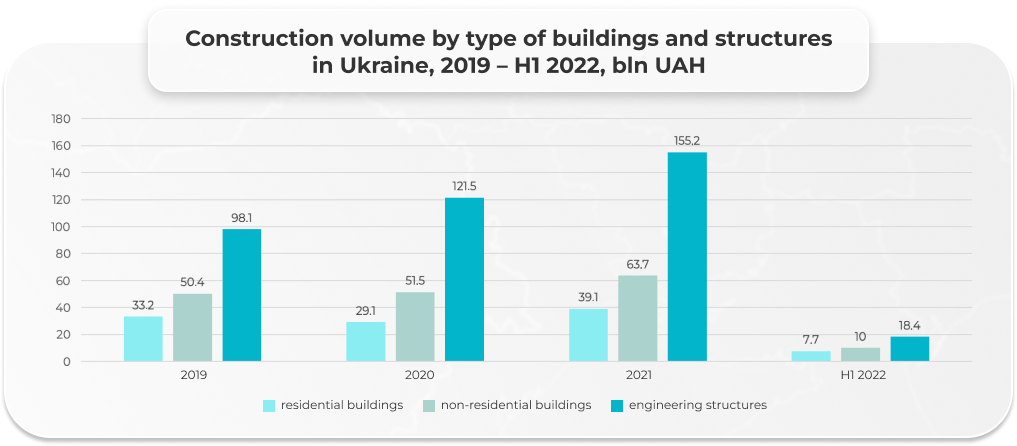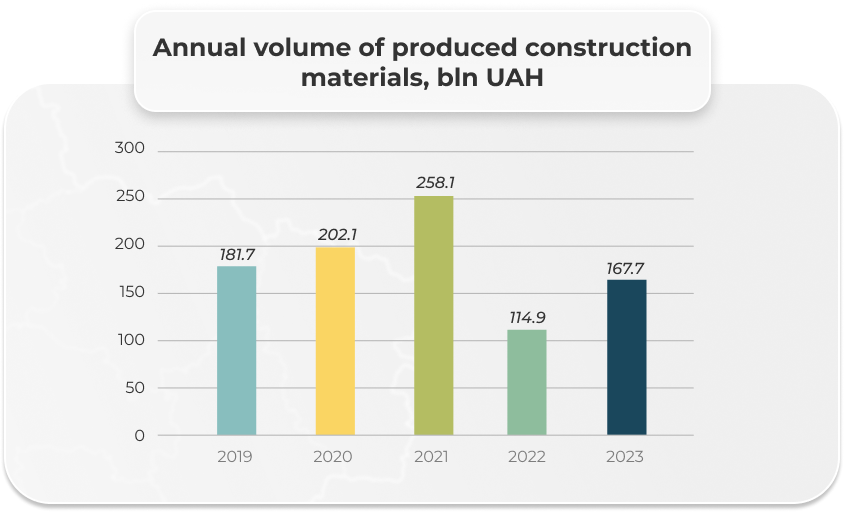Before russia’s full-scale invasion in 2022, Ukraine’s construction materials market exhibited steady growth. From 2016 to 2021, the market’s compound annual growth rate was around 20%, driven by urbanization and infrastructure development, particularly in cities such as Kyiv, Kharkiv, and Odesa. Analysis of construction activity volumes in Ukraine from 2019 to the first half of 2022 indicates substantial growth across all types of buildings and structures, which continued until early 2022.

The war has inflicted significant damage on the construction industry, including the destruction of numerous enterprises specializing in the production of metallurgical products, cement, and bricks, as well as residential and non-residential buildings. At least 15% of companies involved in the production of construction materials have suffered varying degrees of damage. The military actions have also led to the suspension of many construction projects, the destruction of infrastructure, and significant population displacement, creating unfavourable conditions for continuing construction activities during the war. As of June 2024, Ukraine’s construction materials market faces significant challenges and changes. Although the impact of the war remains considerable, the market is beginning to show signs of recovery.

The production of construction materials in Ukraine is heavily dependent on energy resources. According to the National Bank of Ukraine, the energy share in the production of construction materials is up to 10%, with 60% of this energy coming from natural gas.
The most significant losses have been sustained in residential buildings and infrastructure, particularly roads, bridges, and railway facilities, with a total value exceeding 95 billion USD. Other substantial losses include corporate assets and industry at 13.1 billion USD and the energy infrastructure at 9 billion USD, critically impacting the country’s economic stability and recovery prospects. The reconstruction of these assets is a top priority for Ukraine and requires coordinated efforts at both national and international levels, attracting investment, developing long-term strategies, and implementing comprehensive reconstruction programs. This approach will not only restore destroyed assets but also modernize infrastructure to meet contemporary standards, ensuring sustainable economic growth and, as far as possible, improving the population’s well-being.

Amid the widespread destruction caused by the war, approximately 670,000 tons of construction debris have accumulated in Ukraine, presenting a significant potential for recycling. Implementing recycling technologies can not only reduce environmental impact but also create new jobs, contributing to the development of the secondary construction materials industry. A comparative analysis shows that Ukraine’s level of construction materials recycling significantly lags behind leading European countries, highlighting the potential for investment and development.
The prospects of Ukraine’s construction sector are underpinned by its leading positions in the extraction of critical minerals. Ukraine possesses 24 deposits of strategic resources vital to the construction industry. The total value of these mineral resources is estimated at 11.7 billion USD, with their potential encompassing approximately 117 minerals.
Ukraine ranks among the world’s top producers of resources such as gallium, titanium, graphite, and manganese, underscoring its crucial role in the global raw materials market. Additionally, the country has significant reserves of non-ferrous metals and rare earth elements, such as nickel, cobalt, beryllium, and zirconium.
The development of the construction sector in Ukraine largely relies on the availability of a rich raw material base, creating opportunities for establishing new production facilities near the deposits. Such integration ensures the sustainable development of the industry and reduces raw material transportation costs.
Despite the challenges posed by the war and economic instability, Ukraine’s construction market holds significant potential for development. Key factors contributing to market growth include government infrastructure recovery programs, the resumption of construction activities, the adoption of modern technologies, and a focus on environmental standards. Manufacturers that concentrate on these areas will have the opportunity to strengthen their competitive positions and drive industry growth.
Investment opportunities in the construction industry remain attractive due to the high demand for infrastructure and housing reconstruction. Government support and recovery programs create favourable conditions for investors willing to invest in the modernization of production capacities and the adoption of the latest technologies.
Our analytical research covers a wide range of construction materials, including:
– Cement;
– Sand;
– Brick;
– Concrete;
– Aerated concrete;
– Glass;
– Metal;
– Steel;
– Reinforcement bars;
– Dry construction mixes;
– Mineral wool;
– PVC profiles;
– Solar panels.
This research will help investors assess the market, make informed decisions regarding investment opportunities, understand current trends, and evaluate future market development prospects.